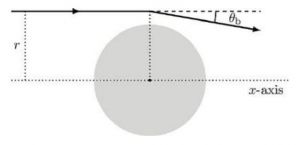2016年IOAA理论第10题-引力透镜望远镜
本题目目前没有解答。要不要你来试试! |
|
英文题目
(T10) Gravitational Lensing Telescope
Einstein's General Theory of Relativity predicts bending of light around massive bodies. For simplicity, we assume that the bending of light happens at a single point for each light ray, as shown in the figure. The angle of bending, 𝜃b , is given by
$$\theta_b =\frac{2R_{sch}}{r}$$
where 𝑅sch is the Schwarzschild radius associated with that gravitational body. We call 𝑟, the distance of the incoming light ray from the parallel 𝑥-axis passing through the centre of the body, as the “impact parameter”.
A massive body thus behaves somewhat like a focusing lens. The light rays coming from infinite distance beyond a massive body, and having the same impact parameter 𝑟, converge at a point along the axis, at a distance 𝑓𝑟 from the centre of the massive body. An observer at that point will benefit from huge amplification due to this gravitational focusing. The massive body in this case is being used as a Gravitational Lensing Telescope for amplification of distant signals.
(T10.1) Consider the possibility of our Sun as a gravitational lensing telescope. Calculate the shortest distance, 𝑓min, from the centre of the Sun (in A. U.) at which the light rays can get focused.
(T10.2) Consider a small circular detector of radius 𝑎, kept at a distance 𝑓min centered on the 𝑥-axis and perpendicular to it. Note that only the light rays which pass within a certain annulus (ring) of width ℎ (where ℎ ≪ 𝑅⊙) around the Sun would encounter the detector. The amplification factor at the detector is defined as the ratio of the intensity of the light incident on the detector in the presence of the Sun and the intensity in the absence of the Sun.
Express the amplification factor, 𝐴m, at the detector in terms of 𝑅⊙ and 𝑎.
(T10.3) Consider a spherical mass distribution, such as dark matter in a galaxy cluster, through which light rays can pass while undergoing gravitational bending. Assume for simplicity that for the gravitational bending with impact parameter, 𝑟, only the mass 𝑀(𝑟) enclosed inside the radius 𝑟 is relevant.
What should be the mass distribution, 𝑀(𝑟), such that the gravitational lens behaves like an ideal optical convex lens?
中文翻译
(T10) 引力透镜望远镜
爱因斯坦的广义相对论预言了光在大质量物体周围的弯曲。为了简便起见,我们假设每个光线的弯曲都发生在一个点上,如图所示。弯曲角度$$\theta_b$$由下式给出
\[ \theta_b = \frac {2R_{\rm sch}} r \]
其中$$R_{\rm sch}$$是与引力体相关的史瓦西半径。我们把入射光线与穿过物体中心的平行轴的距离$$r$$称为“碰撞参数”。
因此,一个巨大的物体的行为有点像一个凸透镜。在大质量物体之外,来自无限远处,具有相同碰撞系数$$r$$的光线聚焦在光轴的同一点上,这一点距离大质量物体中心的距离为$$f_r$$。在这一点上的观测者将受益于引力聚焦带来的巨大放大效应。在这种情况下,这个巨大的天体被用作一个引力透镜望远镜,用来放大遥远的信号。
(T10.1) 考虑将我们的太阳作为引力透镜望远镜的可能性。计算光线可以被聚焦时距离太阳的最短距离$$f_{\rm min}$$。
(T10.2) 考虑一个半径为$$a$$的较小的圆形探测器,保持在最短距离$$f_{\rm min}$$处,以x轴为中心且垂直于x轴。注意,只有通过在围绕太阳的某个宽度为$$h$$($$h \ll R_\odot$$)的环内的光线才会通过探测器。探测器处的放大系数被定义为在有太阳的情况下入射到探测器上的光的强度与在没有太阳的情况下的强度之比。
用$$R_\odot$$和$$a$$表示探测器的放大率$$A_{\rm m}$$。
(T10.3) 考虑一个球形的质量分布,例如星系团中的暗物质,光线在经历引力弯曲时可以通过它。为简便起见,假设对于具有碰撞参数$$r$$的引力弯曲,只考虑半径$$r$$内的质量$$M(r)$$。
如果引力透镜表现地和理想凸透镜一样,那么质量分布$$M(r)$$应该是怎样的?

